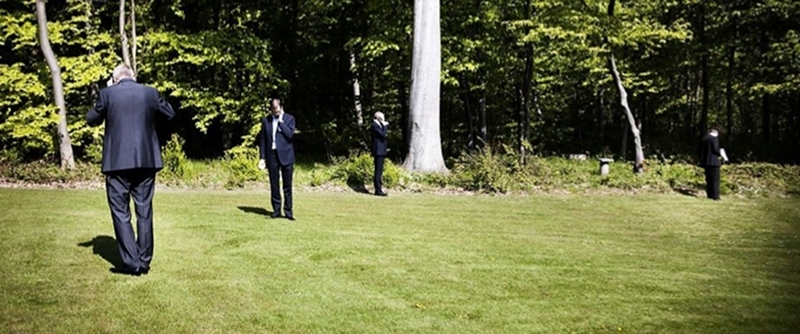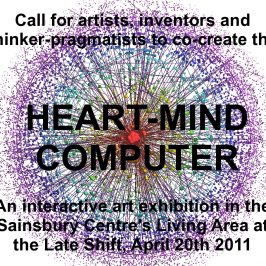My old friend Morten Svenstrup and I am launching the website time-culture.net as a place for dialogue about how we experience time and how this affects our lives individually and collectively. Over the next couple of months we are trying to raise the money to get his thesis on time and culture translated into English and build the website. Please consider helping us in reaching this goal by contributing via our Indiegogo campaign. The following conversation is a cross post from the time culture blog where we will be developing our ideas over the coming months. Feel free to join in the conversation over at time-culture.net!
JDG: You have just finished your thesis on time, art and society in which you analyse three different artworks (compositions by Morten Feldman and Per Nørgård as well as a film by James Benning) in terms of their temporality. You go on to apply your time analysis to wider processes in society. What are the main proposals you develop in this project?
MS: There are two starting points. The first one is that art knows something about time that we humans can learn from. And the other one is that time is the heart of our current social and ecological crises because industrial time – and later network time – accelerate the way we experience time at a pace that organisms can’t keep up with. Then there are further questions around these two statements such as: how does time relate to art, how does time work in society, how can we even talk about time?
The thesis shows how the speed of societal processes has gradually increased during modern history. Today we travel faster, we produce more, we communicate instantaneously etc. We seem to think that what is faster is better – and tend to accelerate social processes according to this belief. This doesn’t count in art though. One of the basic understandings of the thesis is that it doesn’t make sense to try to speed up a piece of music, say. If you do that, you will ruin the piece – or at least change the expression in a fundamental way. That is probably one of the reasons why we find radically different ways of structuring time in artworks than we do in everyday life. One might even talk about artworks as being some kind of reservoir for time structures which society in general is on the verge of forgetting.
In this thesis I have analysed three artworks, all chosen on the basis of the profound way they are organised temporally. They are the works that have made the biggest impression on me from a temporal perspective during the last three or four years. Artworks, of course, are not just objects. They only unfold in interplay with the viewer of the artwork. One might say that the true sense of time in a work of art only emerges in the experience of a viewer. The viewer might experience ways of structuring time that she hasn’t ever met before. And if she lives in a modern high speed world the experience of slowness – which all of the three works are engaged with in one way or the other – might be a totally new experience to her.
Another dimension of the way a piece of art works is the way we tend to listen to it in a particular way. When we know that we are experiencing an artwork, we pay attention to it in a different way than we would to an ordinary object. In figuring out what’s going on in the work the question of temporality is fundamental. In other words, we listen to artworks, and to their attributes – including temporality – with a kind of attention and care that we’re not necessarily used to. If this care and attention can be transferred to our natural surroundings we might learn something that could help us re-engage with the world’s diverse temporalities. This could be the basis of a new culture in which we become more aware of the natural timescapes we live within.
I find that temporal analysis as a tool is powerful when it comes to engaging with some of the ‘big problems’ of today. It is my belief that composing a new time culture – a new way of listening to our surroundings – can help us discover new ways for us humans to inhabit the Earth. And I believe that specific artworks and knowledge about how they are arranged time-wise can be used in this search.
JDG: So what do you mean when you say ‘time’ and ‘arranging time’? How is time arranged?
MS: I am not that interested in what time is. A lot of philosophers have talked about what time is. I’m more interested in asking how time works. And a way of thinking about time is that everything unfolds in time, every action, every thing, every plant, every object, unfolds in time. You could even say, and that is one of the points in the thesis, that everything has it’s own time. If you take a look around you where you are sitting now. I can see a wall over there and a window. Glass is a solid material but if we continue to stare at a window for two hundred years we will see that its fluid. And the time of a window, its temporality, is different to a tree which reacts directly to the changing of seasons and the changes of night and day. Organisms usually respond and unfold in multiple circular time cycles. Time is like a rate of change in things. But for each being, object or process that rate is different and the context is different.
JDG: So saying that things have their own time, or temporality, is a way of saying that things have their own life cycle of birth, maturity, decay and death?
MS: Yea.
JDG: You said time is accelerating in modern society. What do you mean when you say time is speeding up?
MS: Well, for example, if you produce something, if you produce potatoes you would like perhaps produce more because if you produce twice as many potatoes as you did last year you will double your income. So that’s good for you, basically. But if you follow this development for a long time you might find that it becomes problematic. The speeding up of time is directly related to the principle of efficiency and the organising of societal processes according to a view of what is most cost-efficient. This is a kind of logic which doesn’t account for time very well and prioritises short term time horizons.
JDG: You come up with seven diagnoses of how time is changing in your thesis. Let’s talk about the main points and explain a little bit about why they are important to recognise?
MS: This is concerned with working hours. Like how long we work and how intense our work is. It comes down to the fact that the more we can do within a certain time limit, the more we can produce, the better. This is the efficiency principle at work; it is speeding up how much can we produce. How efficient we can be and how many hours a day we work.
JDG: Then you connect this process of increasing speed with the loss of slow temporalities.
MS: Yes, the faster we work, the more intense, the better – at least seen through the eyes of modern society. This leads to a situation where the processes that are not so efficient are seen as bad or unwanted. So for example if an internet browser on our computer is slower then we tend to pick the faster browser. So after a few years this browser probably won’t exist anymore because it is too slow. And you can see the same thing all over society. In social relations as well. One might even say that human beings are sped up too – our actions and our thoughts proceed in a faster pace than in earlier generations.
JDG: Then you make a point about ‘the long view’ which is not being prioritised.
MS: Well yes, we know from physics that the faster the process the less we can say about where it will go on in the future. It is the same thing in society. The faster society moves, the faster it can change its direction and the less we know how it is going to be in five, ten or twenty years. It’s hard to predict the future now. Our grandfathers’ grandfathers probably knew pretty much how the world would be during their lifetime because it would be almost the same as when they were born. But now the things are changing so fast that we have no idea where the world will be in twenty years. And we can also see it in politics. People don’t talk about what is going to happen in a hundred years. People talk about what is going to happen in the next one or two years, perhaps ten, twenty years the most. You don’t find politicians that talk about more than twenty years.
And then the density of information thickening. We are getting bombarded with information all the time and we spend a lot of our life in front of a computer or a phone. In the public space the information density is also increasing. And then the loss of pauses… it is hard to find places in your life where you are not supposed to do anything. For example, work expands. It is not only nine to five, you can always call someone with work related questions, you can always send them a mail. We are never off-duty. We are working all the time.
JDG: One of the last points you make is that we become increasingly ripped out, or decontextualised, from real temporalities, the natural temporalities that surround us.
MS: The loss of pauses is very much about this because what happens when you don’t do anything? Then you tend to notice your surroundings. If you don’t have an agenda then you have the time to notice what is going on around you. If you are constantly on the computer screen, or on your phone, or working in an office, you work inside and with a computer so you aren’t in contact with the time or the rhythms of the seasons. We hardly notice the seasons are changing anymore, we don’t have this rhythm inside of us. You don’t have one year on the internet, the internet is instant. If you go outside the trees know what a year is. We are losing our sense of what a year is, what a day is.
JDG: So what do these seven points say about society as we find it at present in terms of the goals we are striving for, how we view the future and how we move into the future? What does it say about ‘sustainable growth’ for example?
MS: These seven points say that we are working in a system where efficiency is the dominating factor. The only thing we seem to care about as a society is that everything has to go faster. Faster is better. For us to continue to speed up we have to live in a more and more abstract world. For example take this computer, it is very, very fast but it has nothing to do with our surroundings. Where do this high speed come from? It comes from abstraction. The binary number system is one of almost total abstraction, that’s why it is so fast. We live in a world of human science, human communication, which tends to be decontextualised from our surroundings. For society to continue to speed up, our worldview and our sense of what the world is has to become more and more abstract and more and more human. Detached from nature, whatever that is. But what is nature? Nature can be seen as our surroundings in a temporal perspective. For example, to be able to say how we as human beings can live in a sustainable way will take a shift in how we think about time: from being an abstract category it has to become recontextualized – even tactile. The world we live in has it’s own time and we have to respect it.
JDG: How do we do that? You are suggesting that we start to build a new time culture and that we pay attention to the natural temporalities and start becoming more aware about time. How do we do that? How do we move in that direction?
MS: Well, the first thing is to become aware of our surroundings and their temporalities. As soon as we get aware of time as an embodied phenomenon, we have the possibility to navigate the timescapes of everyday life. We can actually choose to be faster or we can choose not to. We can choose to be slower even. We do have this decision as human beings. If we don’t think about time we just continue to speed up along with the society around us but if we insist on creating a time culture we can implement some kind of listening to our surroundings and follow our surroundings’ own temporality. We can implement this in everything that we do, basically. That is the beginning of a new culture in which we become aware of time as a tactile, embodied and lived phenomenon.
JDG: So what do you hope to do with time-culture.net?
MS: I hope to share ideas with whoever is interested. The topic of time is so broad that I think almost everyone can relate to it in one way or the other. But still the topic of time is rooted, rooted in nature, and this, I hope, can create a healthy and even ‘physical’ basis for further philosophical and practical discussions. I hope a lot of people from various backgrounds will participate and help evolve these theories. Ideally, I hope that we can develop these theories to be consistent enough to become a kind of backbone in political discussions, ecological matters and so forth. Basically, the aim of time culture is to take responsibility for our actions and to find ways of living balanced lives and this means, I think, living in synchrony with the natural temporalities that surround us.






Ragnarok and the fate of the Danish soul
has to have constellating images to pull together all these tendencies to separation,...